Happiness, prosperity, longevity or fú lù shòu: three words that brilliantly sum up the most grandiose festival in China. You will quickly understand… China: discovering the Chinese New Year!
Summary
- The History of Chinese New Year
- Preparations: the “little” Chinese New Year
- Course of the party
- – Food, money and firecrackers
- – Insomnia, morning prayers and house tours
- – Et ça continue, encore et encore
- – La fête des lanternes
- – Le Nouvel An chinois à travers le monde
- Where to live your first New Year in China?
- – Hong Kong parade
- – Shanghai illuminates
- – Beijing represents
- – The campaign perpetuates
- What you don’t know about Chinese New Year
- – Celibacy: between shame and annoyance
- – Buy Janitor’s Silence
- – Dozens of taboos around the New Year
The Chinese New Year celebrates, like New Year’s Day in our Gregorian calendar, the transition to the new year. Just the name arouses the imagination: costumes in caustic colors, eccentric patterns, pomp and celebration, lion-headed dragons meandering through the streets and millions of flamboyant lanterns in the night.
However, all this is not a dream. The Chinese New Year is as beautiful, extravagant and extraordinary as you imagine. It is also an opportunity for the Chinese to celebrate spring, which is just around the corner. Hence the name Spring Festival. The end of winter, the milder temperatures that set in, the flowering of the countryside that slowly takes over and the exceptional luminosity of the moon that sets in: this low tourist season has a lot to offer. Today, we invite you to the heart of this tradition. Follow our adventure in the Middle Kingdom, at its happiest and most folkloric hours.
L’histoire du Nouvel An chinois
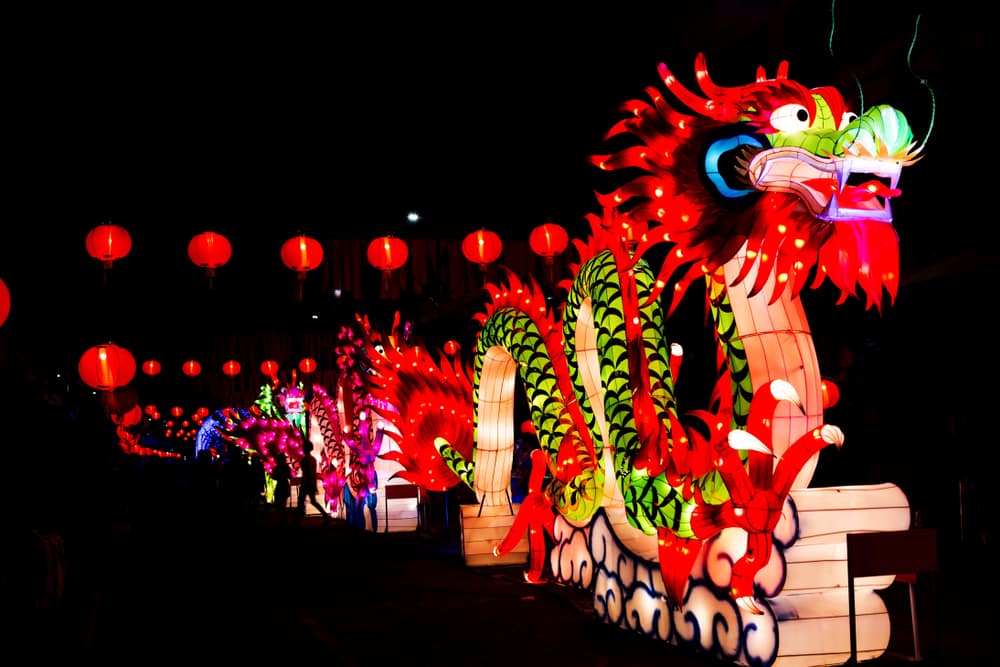
Iconic Chinese New Year dragon – Photo credit: Shutterstock – Aut Pantian
If today this holiday has gone far beyond the borders of China, few people really know the history of the Chinese New Year. Who is the iconic mysterious dragon? Where does this national enthusiasm for the new year come from? Why all these lights, these symbols, these explosions?
Depuis la chute du régime impérial au profit de la République de Chine, en 1912, le pays a officiellement adopté le calendrier grégorien. Malgré ce désir stratégique et politique de calquer le modèle occidental, les chinois restent très attachés à leur calendrier lunaire. Ce dernier continue de rythmer leurs années et fait le pont entre présent et passé.
As a result, the Chinese would not miss the New Year celebration for anything in the world! It is even the essential condition for the development of a good year, far from the old demons of the past and failures. The two weeks following the first day of the year are also placed under the sign of the festival, commonly known as the Spring Festival. In January and February, a large part of China flirts with freezing temperatures and is confined under a blanket of snow. These fortnights are therefore an ode to the long-awaited thaw which, in the past, coincided with the return of nourishing agricultural activity.
The day when we enter the new year is called the Nian . It takes its name from a legendary creature, resembling a bull with a lion’s head, wandering the lands of China. According to legend, this mythical and hybrid monster came out of the forests every year, during winter nights, to devour the villagers. He left just before daybreak. Over the years, the villagers understood that the creature ended its bloody feast at dawn because it feared light, sound and red. As the fateful date approached, they got into the habit of sheltering inside their house, leaving the lights on, putting all sorts of red decorations in bloom, drumming on saucepans and, little little by little, to explode firecrackers and big fires.
Nowadays, the parades that mark the New Year, whose star is this famous Nian , symbolize the domestication of this demonic animal and the victory of the Chinese over this scourge.
Commonly, each year of the lunar calendar is also placed under the sign of one of the astrological animals which are the rat, the buffalo, the tiger, the rabbit, the dragon, the snake, the horse, the goat, the monkey, the rooster, dog and pig, as well as one of water, fire, metal, wood and earth. The Chinese zodiac sign is thus defined by their year of birth.
Préparatifs : le « petit » Nouvel An chinois
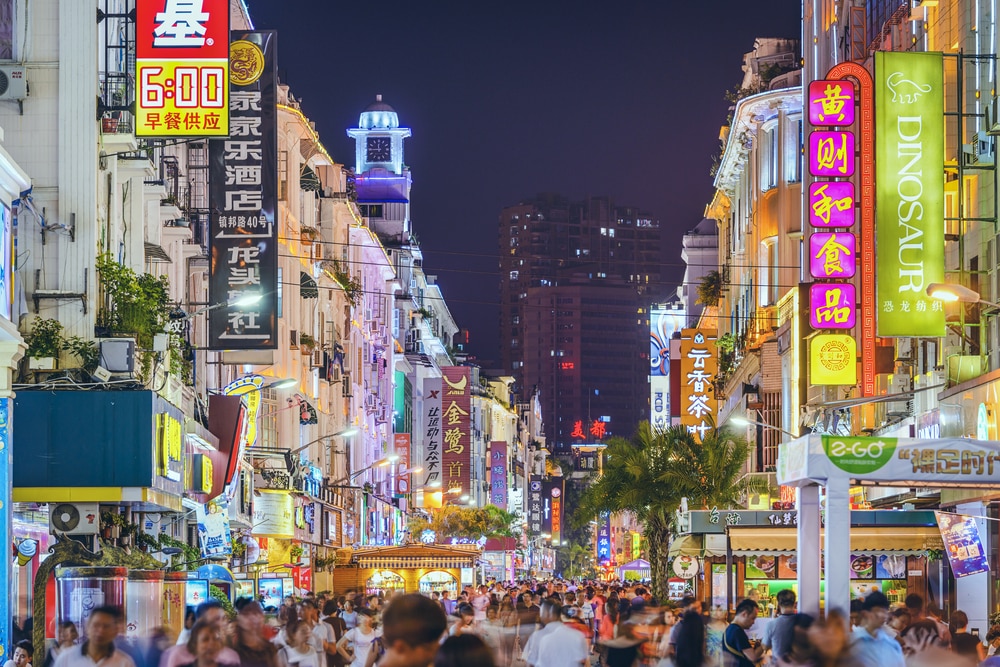
Chinese people are flocking to stores to shop for the New Year – Photo credit: Shutterstock – Sean Pavone
After this short return to the origins of the New Year, place to the present story of this celebration of all superlatives. The Generation Voyage teams have packed their bags, heading to China.
Chaque année, le Nouvel An chinois tombe entre le 21 janvier et le 20 février de notre calendrier grégorien. Heureusement, la date est connue suffisamment à l’avance pour que chaque famille ait le temps de s’affairer aux préparatifs. À l’approche du réveillon, le pays entier est gagné par une atmosphère particulière, entre impatience et affairement intense.
We set foot in the Middle Kingdom a week before the real Chinese New Year to celebrate the “little” New Year. During this period, the Chinese seek the good graces of the god of the hearth by depositing food on representations at his effigy. Already, under the winter sun, the red mass is activated. Cities, from floor to ceiling, take on the color of hot embers. At the doorsteps, the dust rises gently. It comes from the great cleaning carried out by the Chinese. The inhabitants symbolically sweep away the bad things of the past to make way for the happiness to come.
Besides, it is better to dust your house now because during the days following the New Year, cleaning your home brings bad luck. It would be tantamount to chasing away the luck newly introduced into the house. The Chinese also take the opportunity to make themselves beautiful because, just like cleaning, it is good not to wash and cut your hair in the days following the New Year.
Then comes the hiding place of dozens of small rolled up red papers, to be placed discreetly in the rooms of the house. The family members scratch a few wishes for the following year. The tradition also wants families to write a poetic verse on a small red ribbon, to be framed around their door. This then gives an incredibly photogenic look to the streets: a godsend for photography enthusiasts!
During this week, there is also a real rush in the stores. It must be said that for the occasion and for almost a week, the stores are closing their doors. The Chinese first stock up on food: dried fruits and sweets abound in homes. Then, there is no question of skimping on the New Year’s Eve meal which brings the whole family together with the elders. They also buy their red party outfits at unbeatable prices. The most traditionalists will even take the opportunity to renew their wardrobe in order to be ready for the arrival of spring.
La veille du Nouvel An, les maisons sont soigneusement décorées. Au sein des familles, on ressent l’excitation, la trépidation… mais aussi un discret sentiment de stress.
Déroulement de la fête
Food, money and firecrackers

Repas du Réveillon du Nouvel An chinois en famille – Crédit photo : Shutterstock – Liudmila Kotvitckaia
Le repas du réveillon est une histoire de famille. Ici, pas question ne serait-ce que de tremper les lèvres dans un verre tant que toute la famille n’est pas réunie ! On comprend aisément pourquoi les retards sont si mal venus.
Copious is the watchword: fish symbol of opulence, spring rolls and ravioli symbols of wealth, noodles symbol of longevity and happiness, and Niango (New Year’s cake) symbol of growth. Of course (this is not a legend), we exchange at the end of the meal the traditional lucky cookies which contain predictions for the coming year. Oranges and tangerines also surge for dessert. These citrus fruits are considered lucky fruits, attracting luck, prosperity and abundance.
Less appetizing, there are also some smelly seaweed or dried oysters on the table. These dishes that have the smell of “smelly feet” are highly symbolic. If there is some on your plate, there is no escaping it. These foods also mean money and good luck.
During the meal, family members, especially single people, receive red envelopes containing money. Moreover, the days following New Year’s Eve, it is customary to bring this same kind of gift to the children and unmarried people of the families that we visit. Some receive up to the equivalent of 1,000 euros in one evening! Be careful though: never offer an amount that includes a 4! This figure, which is pronounced like the word death in Chinese, is abhorred in the country. A bit nostalgic, we will nevertheless find that this paper tradition has gradually given way to electronic New Year’s Eve. One thing is certain: money has a central place in China. In Asian culture, wealth is as important as health.
À la fin du repas, à l’heure où les estomacs entament difficilement la digestion et que sonnent les douze coup de minuit, les pétards et feux de Bengale explosent dans les rues. Un spectacle donné à cœur joie par les enfants, mais de plus en plus encadré à cause des multiples accidents.
Insomnies, prières matinales et tour des maisons
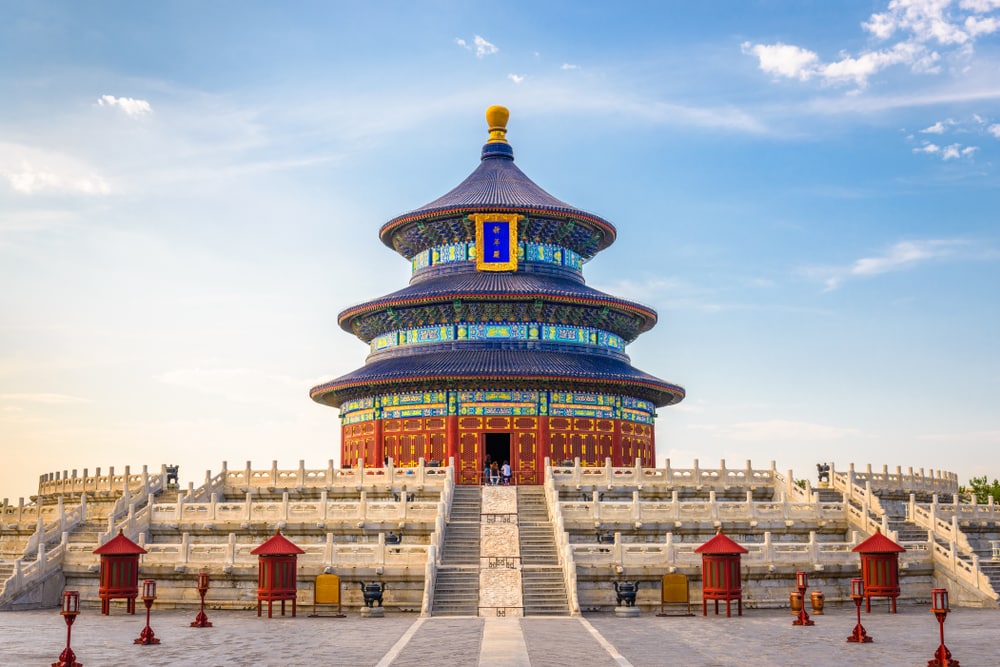
Temple of Heaven, Beijing, China – Photo credit: Shutterstock – Sean Pavone
If we can easily laugh at our sleepless nights at home, bedtime is taken very seriously among the Chinese. Here, it’s up to the one who goes to bed as late as possible because the less you sleep that night, the more you lengthen your life! Games and screens are in order to keep minds awake. Moreover, a show is given that evening on TV. The hearings explode the world counters, even more than the American Super Bowl! Popular singers, comedians, representations of ethnic minorities and communist propaganda against a backdrop of music resonate in the cottages.
Despite the cruel lack of sleep and the body a little badly led by the sake, the first morning of the new year must take place at the temple. Everyone must arrive early to promote luck for the year that begins. Some temples in China even open at midnight sharp and others are packed to the point of a veritable morning rush. In the middle of the alleys, the smoke from the thousands of incense sticks brandished by the crowd zigzags in the sky. Children and adults, decked out in shimmering clothes, kneel down and mumble prayers.
And it goes on and on and on
On the second day, the couples and the children also go to the mother’s family. The color red still dominates, giving rise to a veritable broom of red ants circulating throughout China.
Les jours suivants sont consacrés à toutes sortes de célébrations aux dieux de la richesse, du ciel, etc. Et on danse aussi. Notamment la danse du lion. Cette danse traditionnelle pratiquée lors de la période du Nouvel An a aussi lieu pendant les mariages et autres évènements importants. Deux danseurs s’enferment dans un costume de lion, leurs quatre jambes représentants les quatre pattes, et se déhanchent avec une technicité et une habilité épatantes. Cette pratique issue des arts martiaux, qui porte chance et éloigne les mauvais esprits, rappelle également la légende du Nian (ou Nianshou).
At the end of the fifth day, the stores reopen their doors. Finally, the spring festival extends over no less than two weeks, and the end of the festivities is marked by the unmissable lantern festival.
The Lantern Festival

Fête des lanternes en Chine – Crédit photo : Shutterstock – apiguide
This is probably the peak of the festivities around the Chinese New Year. Few shows compete in terms of magnificence. For centuries, these lanterns igniting the sky were the effigy of various mythological characters. Today, it is rather the faces of new cartoon characters that rise in the night. Then, the modern era gave way to luminous tanks. What a show !
When it comes to food, it’s an opportunity to taste all kinds of soups and stuffed rice dumplings: a generous family recipe that has gone far beyond Chinese borders.
Chinese New Year around the world

Thean Hou Temple lit up for the Chinese New Year celebrations, Kuala Lumpur, Malaysia – Photo credit: Shutterstock – Travelpixs
This festival synonymous with holidays, gatherings, traditions and culture has seduced countries around the world. Today, although the charm on site is incomparable, you can quite celebrate the Chinese New Year outside the Middle Kingdom.
All around the Republic of China, countries like Taiwan and the two regions of the People’s Republic of China (Hong Kong and Macao) do not ignore this ancestral festival. In Singapore, Malaysia, the Philippines, Brunei, Indonesia, South Korea and even Thailand, the inhabitants are unemployed for the occasion and have a blast with the festivities. It must be said that all these states are largely influenced by Chinese culture.
Finally, be aware that the Chinese diaspora has even reached Europe and France. From Paris to Lyon via other provincial towns, this is an opportunity to travel close to home.
Where to live your first New Year in China?
Hong Kong parade

Fireworks in Hong Kong – Photo credit: Shutterstock – Krunja
Breathtaking fireworks, floats of cyclopean dimensions, thousands of doors set with lanterns, incense at the doors of temples, phantasmagorical shows: this is one of the most prestigious New Year’s celebrations in the country. In Hong Kong, it is a tradition to also give flowers for the New Year. The best place to find them? In traditional markets teeming with people and experiences for the senses.
Shangaï illumine

Longhua Temple in Shanghai, China – Photo credit: Shutterstock – ItzaVU
It is undoubtedly in the heart of this pearl of the Middle Kingdom that you will experience the most beautiful lantern festival. The city, under the spotlight, offers an exceptional moment in the Yuyuan garden . If there is a maddening amount of traditional lanterns, there are also a good number of lights combining ancestral art and modern technology. Here too, it is appropriate to offer bouquets and potted plants. To attend religious celebrations, go to Longhua Temple . Dances and songs resound in the place for more than a week. Throughout the city, the pyrotechnic wars are going well, but it is probably on the Bund that the show is the most mind-blowing.
Pékin représente

Wall of China – Photo credit: Shutterstock – zhanglianxun
The one nicknamed the Forbidden City opens its arms wide to travelers and Beijingers in search of a monumental party. The capital gives pride of place, like nowhere else, to multiple performances: dragon dances, lion dances, imperial plays, fireworks from the Wall of China: it is a real whirlwind of sounds, colors, smells and flavors for fifteen days. But in Beijing, strings of firecrackers to ward off bad luck are banned in the streets.
The campaign perpetuates
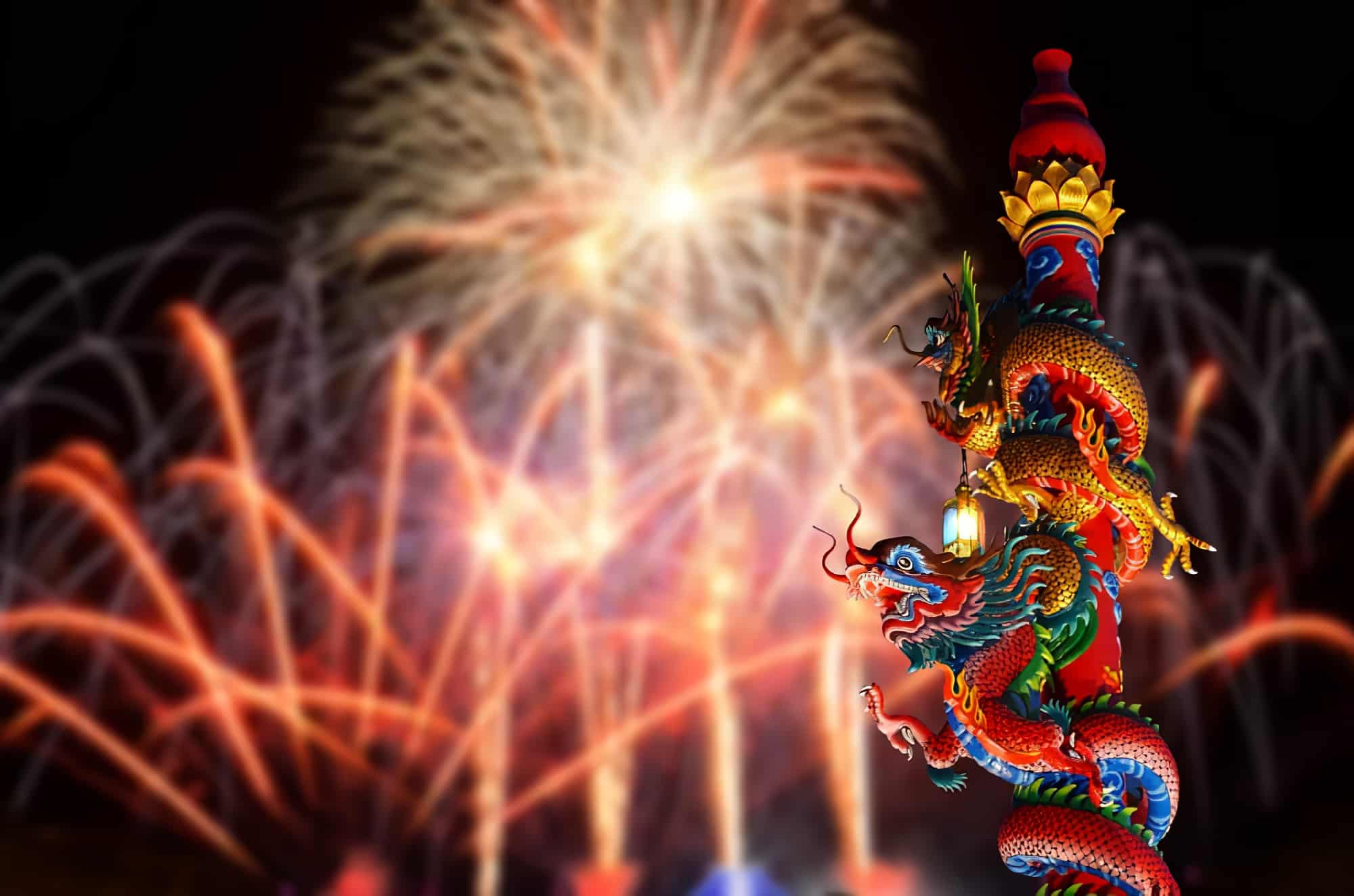
Fireworks for Chinese New Year – Photo credit: Shutterstock – Sonpichit Salangsing
In the Chinese countryside, celebrations and entertainment are in full swing. In particular thanks to the migratory flows which take place throughout the festivities. The reunion here has something even more poignant. Celebrations have that delicious touch of authenticity. Hospitality is king and it is undoubtedly the place of choice for a Chinese New Year under the sign of simplicity, sharing and love. It is also far from the big cities that you can witness real flights of firecrackers and fireworks fired by the inhabitants. Where, logically, safety and environmental issues pose fewer problems.
A national and large-scale holiday, the Chinese New Year rhymes with overcrowding on the roads, in stations and airports. It is even the largest human transhumance in the world. So remember to book well in advance and be patient if you embark on an itinerant trip during this period.
Ce que vous ne savez pas sur le Nouvel An chinois
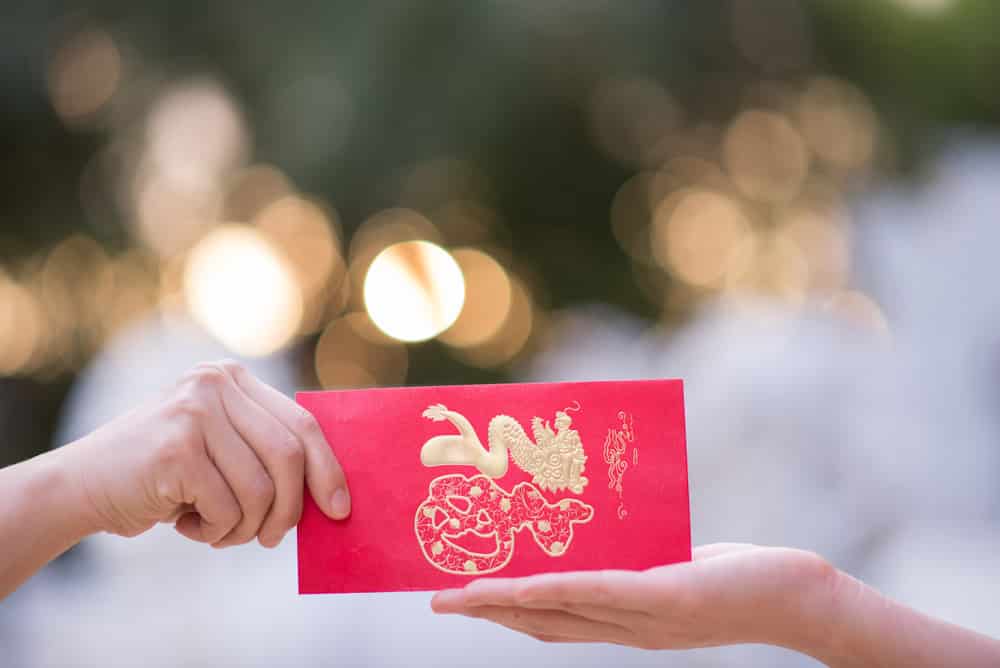
The famous red envelopes full of money, offered for the Chinese New Year – Photo credit: Shutterstock – nokkaew
Celibacy: between shame and annoyance
As you will have understood, the family dimension is as important as the religious and festive dimensions. So much so that some Chinese have resorted to the services of a fake boyfriend or a fake girlfriend in order to spend the New Year with their family and without incident. And this even if their celibacy allows them to receive en masse the famous red envelopes full of money. Indeed, while the couples live a moment of intense joy, the Tanguys of celibacy (after 32 years for men and after 30 years for women) suffer the mockery of their peers and the sermons of their parents. Renting a “soul mate” to spend the holidays, you had to dare!
Buy the janitor’s silence
Concierges receive quite a few red envelopes… Why? These caretakers who have ears and eyes everywhere generally know all the secrets of the inhabitants. Even the most unmentionable. It is therefore common to slip a little money to your concierge when you have a secret to keep warm…
Dozens of taboos around the New Year
We told you, we don’t wash our hair and we don’t sweep, but what are the other Chinese New Year taboos?
- During the festivities, one does not wash one’s clothes on the first and second day of the year;
- Drugs are avoided at the risk of provoking the disease during the year which begins;
- If you are the victim of theft, the penalty is double because this is also a prelude to illness;
- During the first breakfast, we skip the rice porridge. Considered the dish of the poor, it would break the circle of prosperity;
- A child is crying? Ouch, that’s a bad sign. So much so that some Chinese parents are ready for all parades to snatch smiles from their offspring;
- Lovers of sewing and DIY are asked to put away their instruments: scissors, knives and objects that could cause accidents are necessarily discouraged. As always, they are renowned for their harmful influences, especially on the annual nest egg;
- As for gambling addicts or people in debt: it is better to start the year clear with your debts and your banker.
